Capstone Project: System Implementation Plan for Verbania, Inc.
VerifiedAdded on 2022/08/26
|6
|1141
|19
Project
AI Summary
This document outlines a system implementation plan designed for Verbania Inc., a company seeking to re-enter the social networking market after a previous shutdown. The plan addresses the company's need for a complete IT solution, encompassing hardware, software, networking, and security. It details user requirements such as account creation, forums, search capabilities, gaming, calendars, instant messaging, and secure communication. Company requirements include data collection, content management, and system availability. The plan emphasizes the importance of user categories, system support services, and the right infrastructure for monitoring and compliance. It also focuses on information security, including personnel security, information control, and physical security measures. The plan is based on ISO 27002/17999 standards, and includes references to relevant academic sources.
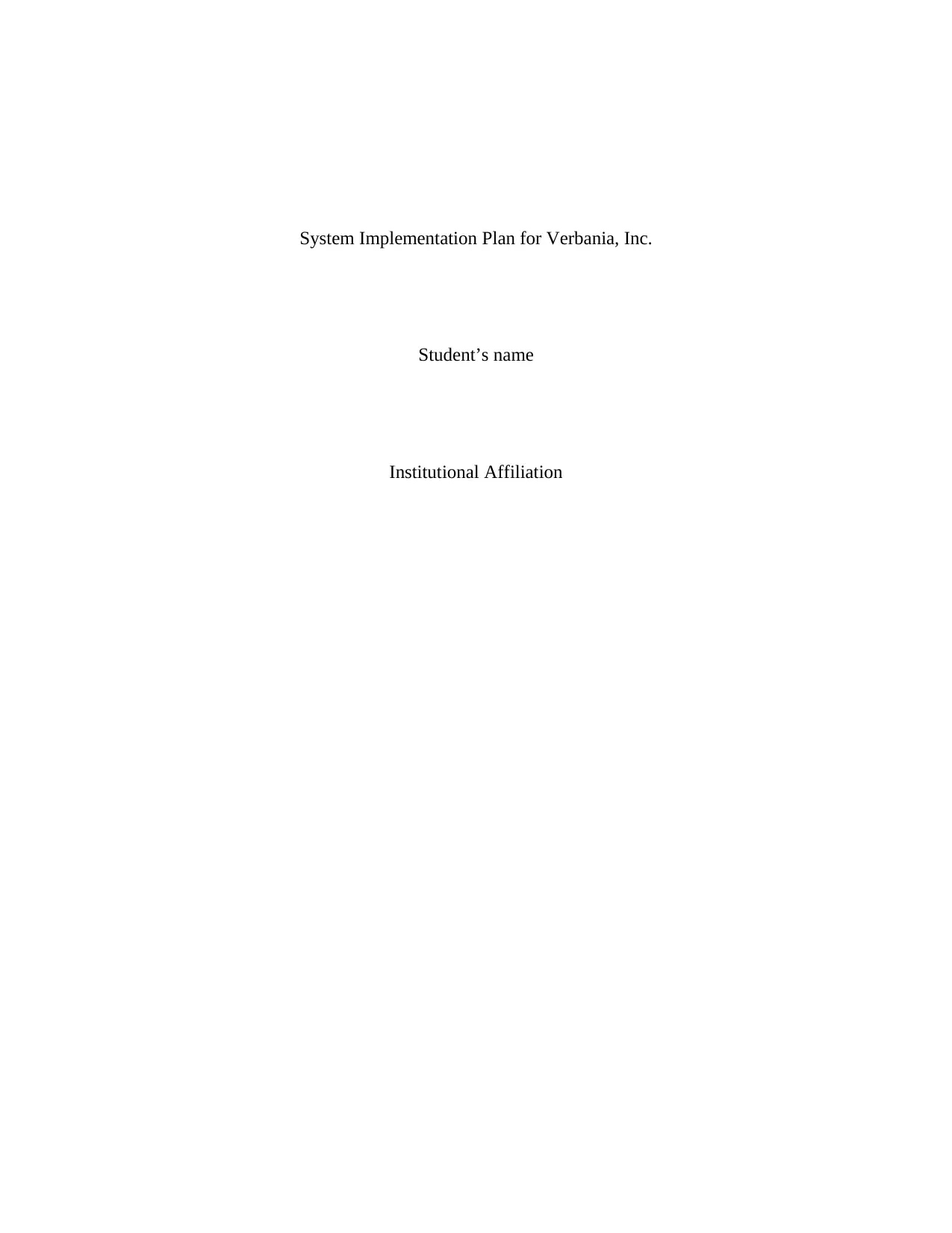
System Implementation Plan for Verbania, Inc.
Student’s name
Institutional Affiliation
Student’s name
Institutional Affiliation
Paraphrase This Document
Need a fresh take? Get an instant paraphrase of this document with our AI Paraphraser
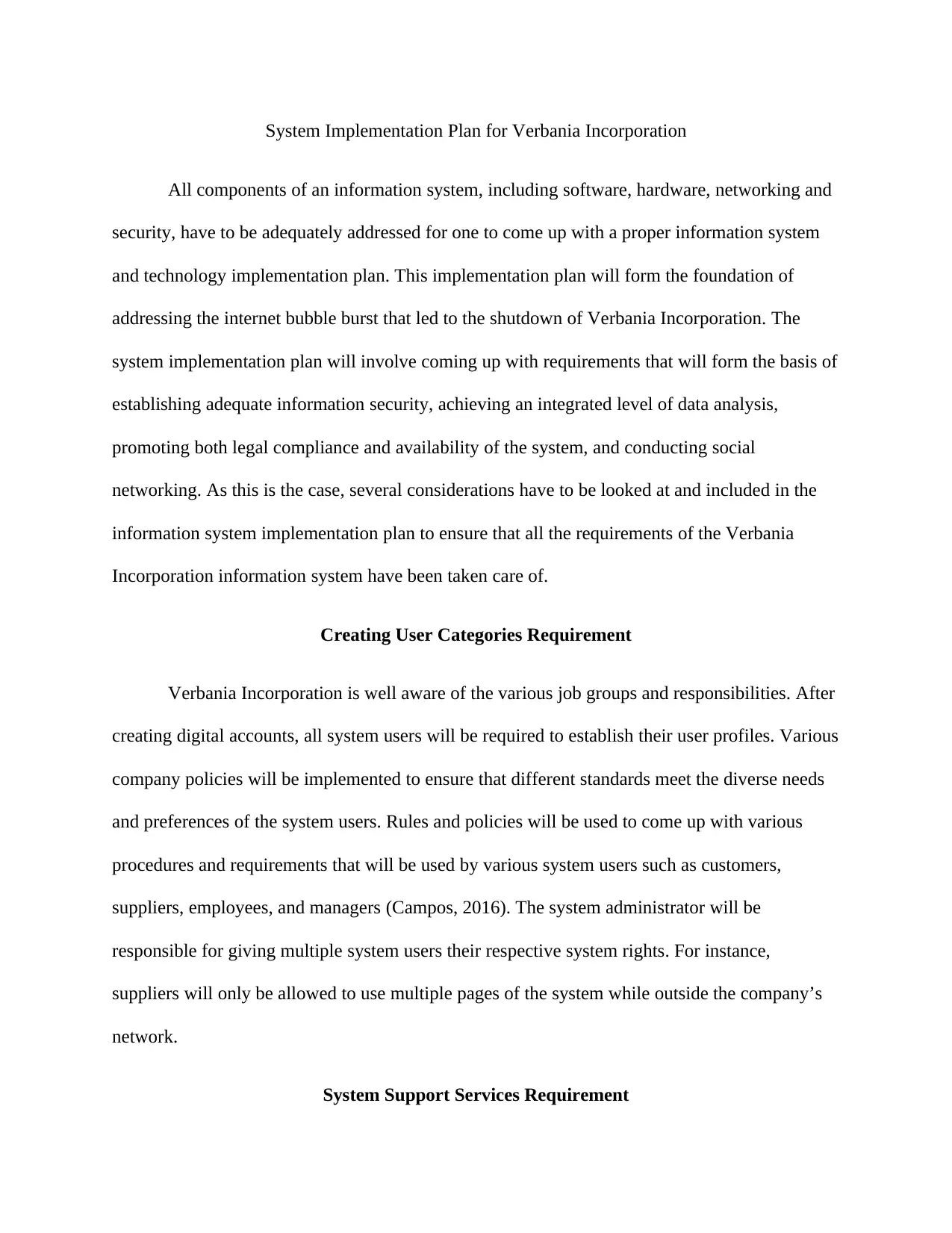
System Implementation Plan for Verbania Incorporation
All components of an information system, including software, hardware, networking and
security, have to be adequately addressed for one to come up with a proper information system
and technology implementation plan. This implementation plan will form the foundation of
addressing the internet bubble burst that led to the shutdown of Verbania Incorporation. The
system implementation plan will involve coming up with requirements that will form the basis of
establishing adequate information security, achieving an integrated level of data analysis,
promoting both legal compliance and availability of the system, and conducting social
networking. As this is the case, several considerations have to be looked at and included in the
information system implementation plan to ensure that all the requirements of the Verbania
Incorporation information system have been taken care of.
Creating User Categories Requirement
Verbania Incorporation is well aware of the various job groups and responsibilities. After
creating digital accounts, all system users will be required to establish their user profiles. Various
company policies will be implemented to ensure that different standards meet the diverse needs
and preferences of the system users. Rules and policies will be used to come up with various
procedures and requirements that will be used by various system users such as customers,
suppliers, employees, and managers (Campos, 2016). The system administrator will be
responsible for giving multiple system users their respective system rights. For instance,
suppliers will only be allowed to use multiple pages of the system while outside the company’s
network.
System Support Services Requirement
All components of an information system, including software, hardware, networking and
security, have to be adequately addressed for one to come up with a proper information system
and technology implementation plan. This implementation plan will form the foundation of
addressing the internet bubble burst that led to the shutdown of Verbania Incorporation. The
system implementation plan will involve coming up with requirements that will form the basis of
establishing adequate information security, achieving an integrated level of data analysis,
promoting both legal compliance and availability of the system, and conducting social
networking. As this is the case, several considerations have to be looked at and included in the
information system implementation plan to ensure that all the requirements of the Verbania
Incorporation information system have been taken care of.
Creating User Categories Requirement
Verbania Incorporation is well aware of the various job groups and responsibilities. After
creating digital accounts, all system users will be required to establish their user profiles. Various
company policies will be implemented to ensure that different standards meet the diverse needs
and preferences of the system users. Rules and policies will be used to come up with various
procedures and requirements that will be used by various system users such as customers,
suppliers, employees, and managers (Campos, 2016). The system administrator will be
responsible for giving multiple system users their respective system rights. For instance,
suppliers will only be allowed to use multiple pages of the system while outside the company’s
network.
System Support Services Requirement
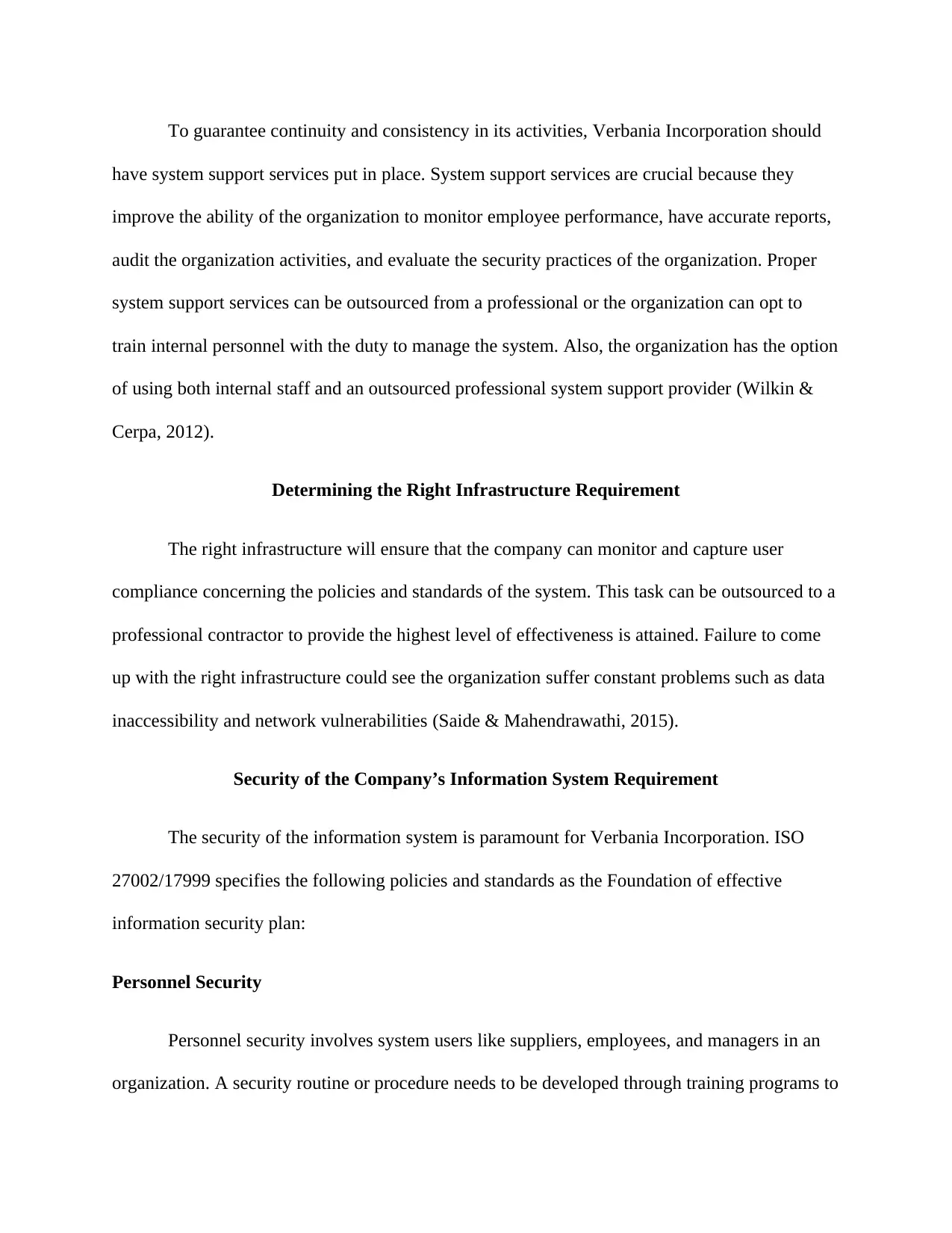
To guarantee continuity and consistency in its activities, Verbania Incorporation should
have system support services put in place. System support services are crucial because they
improve the ability of the organization to monitor employee performance, have accurate reports,
audit the organization activities, and evaluate the security practices of the organization. Proper
system support services can be outsourced from a professional or the organization can opt to
train internal personnel with the duty to manage the system. Also, the organization has the option
of using both internal staff and an outsourced professional system support provider (Wilkin &
Cerpa, 2012).
Determining the Right Infrastructure Requirement
The right infrastructure will ensure that the company can monitor and capture user
compliance concerning the policies and standards of the system. This task can be outsourced to a
professional contractor to provide the highest level of effectiveness is attained. Failure to come
up with the right infrastructure could see the organization suffer constant problems such as data
inaccessibility and network vulnerabilities (Saide & Mahendrawathi, 2015).
Security of the Company’s Information System Requirement
The security of the information system is paramount for Verbania Incorporation. ISO
27002/17999 specifies the following policies and standards as the Foundation of effective
information security plan:
Personnel Security
Personnel security involves system users like suppliers, employees, and managers in an
organization. A security routine or procedure needs to be developed through training programs to
have system support services put in place. System support services are crucial because they
improve the ability of the organization to monitor employee performance, have accurate reports,
audit the organization activities, and evaluate the security practices of the organization. Proper
system support services can be outsourced from a professional or the organization can opt to
train internal personnel with the duty to manage the system. Also, the organization has the option
of using both internal staff and an outsourced professional system support provider (Wilkin &
Cerpa, 2012).
Determining the Right Infrastructure Requirement
The right infrastructure will ensure that the company can monitor and capture user
compliance concerning the policies and standards of the system. This task can be outsourced to a
professional contractor to provide the highest level of effectiveness is attained. Failure to come
up with the right infrastructure could see the organization suffer constant problems such as data
inaccessibility and network vulnerabilities (Saide & Mahendrawathi, 2015).
Security of the Company’s Information System Requirement
The security of the information system is paramount for Verbania Incorporation. ISO
27002/17999 specifies the following policies and standards as the Foundation of effective
information security plan:
Personnel Security
Personnel security involves system users like suppliers, employees, and managers in an
organization. A security routine or procedure needs to be developed through training programs to
⊘ This is a preview!⊘
Do you want full access?
Subscribe today to unlock all pages.

Trusted by 1+ million students worldwide
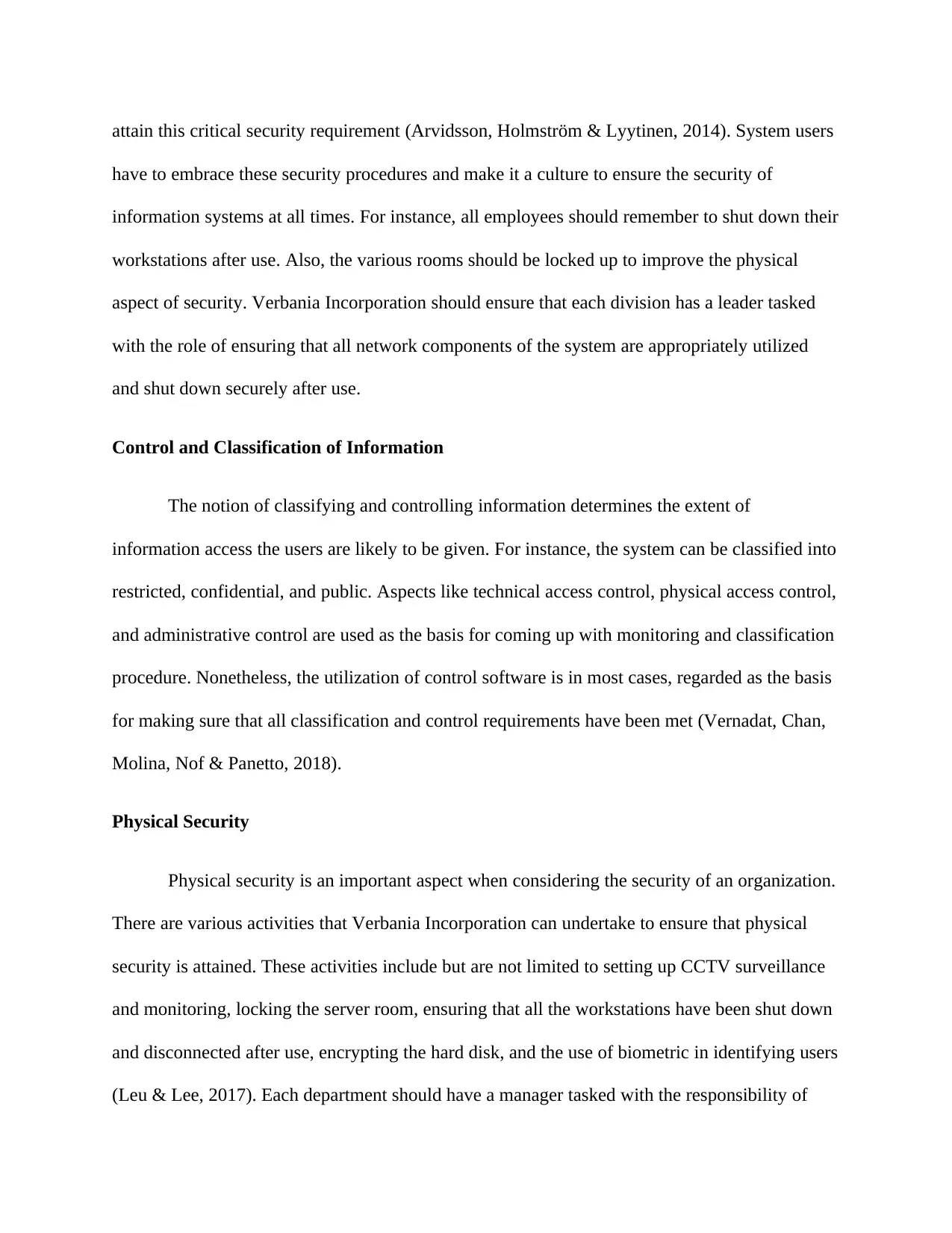
attain this critical security requirement (Arvidsson, Holmström & Lyytinen, 2014). System users
have to embrace these security procedures and make it a culture to ensure the security of
information systems at all times. For instance, all employees should remember to shut down their
workstations after use. Also, the various rooms should be locked up to improve the physical
aspect of security. Verbania Incorporation should ensure that each division has a leader tasked
with the role of ensuring that all network components of the system are appropriately utilized
and shut down securely after use.
Control and Classification of Information
The notion of classifying and controlling information determines the extent of
information access the users are likely to be given. For instance, the system can be classified into
restricted, confidential, and public. Aspects like technical access control, physical access control,
and administrative control are used as the basis for coming up with monitoring and classification
procedure. Nonetheless, the utilization of control software is in most cases, regarded as the basis
for making sure that all classification and control requirements have been met (Vernadat, Chan,
Molina, Nof & Panetto, 2018).
Physical Security
Physical security is an important aspect when considering the security of an organization.
There are various activities that Verbania Incorporation can undertake to ensure that physical
security is attained. These activities include but are not limited to setting up CCTV surveillance
and monitoring, locking the server room, ensuring that all the workstations have been shut down
and disconnected after use, encrypting the hard disk, and the use of biometric in identifying users
(Leu & Lee, 2017). Each department should have a manager tasked with the responsibility of
have to embrace these security procedures and make it a culture to ensure the security of
information systems at all times. For instance, all employees should remember to shut down their
workstations after use. Also, the various rooms should be locked up to improve the physical
aspect of security. Verbania Incorporation should ensure that each division has a leader tasked
with the role of ensuring that all network components of the system are appropriately utilized
and shut down securely after use.
Control and Classification of Information
The notion of classifying and controlling information determines the extent of
information access the users are likely to be given. For instance, the system can be classified into
restricted, confidential, and public. Aspects like technical access control, physical access control,
and administrative control are used as the basis for coming up with monitoring and classification
procedure. Nonetheless, the utilization of control software is in most cases, regarded as the basis
for making sure that all classification and control requirements have been met (Vernadat, Chan,
Molina, Nof & Panetto, 2018).
Physical Security
Physical security is an important aspect when considering the security of an organization.
There are various activities that Verbania Incorporation can undertake to ensure that physical
security is attained. These activities include but are not limited to setting up CCTV surveillance
and monitoring, locking the server room, ensuring that all the workstations have been shut down
and disconnected after use, encrypting the hard disk, and the use of biometric in identifying users
(Leu & Lee, 2017). Each department should have a manager tasked with the responsibility of
Paraphrase This Document
Need a fresh take? Get an instant paraphrase of this document with our AI Paraphraser

ensuring physical security. Automated backup tools should also be used to improve physical
security.
security.
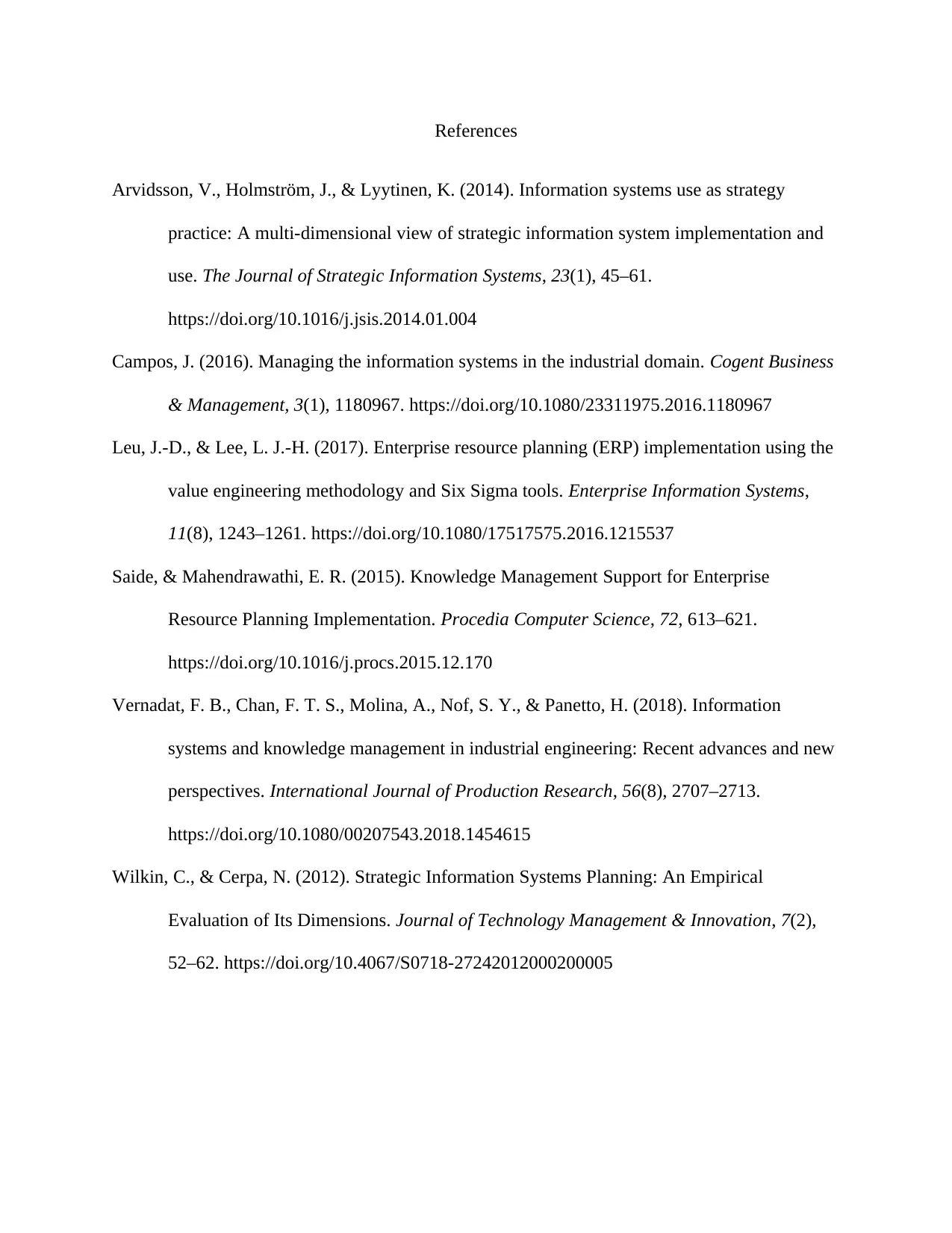
References
Arvidsson, V., Holmström, J., & Lyytinen, K. (2014). Information systems use as strategy
practice: A multi-dimensional view of strategic information system implementation and
use. The Journal of Strategic Information Systems, 23(1), 45–61.
https://doi.org/10.1016/j.jsis.2014.01.004
Campos, J. (2016). Managing the information systems in the industrial domain. Cogent Business
& Management, 3(1), 1180967. https://doi.org/10.1080/23311975.2016.1180967
Leu, J.-D., & Lee, L. J.-H. (2017). Enterprise resource planning (ERP) implementation using the
value engineering methodology and Six Sigma tools. Enterprise Information Systems,
11(8), 1243–1261. https://doi.org/10.1080/17517575.2016.1215537
Saide, & Mahendrawathi, E. R. (2015). Knowledge Management Support for Enterprise
Resource Planning Implementation. Procedia Computer Science, 72, 613–621.
https://doi.org/10.1016/j.procs.2015.12.170
Vernadat, F. B., Chan, F. T. S., Molina, A., Nof, S. Y., & Panetto, H. (2018). Information
systems and knowledge management in industrial engineering: Recent advances and new
perspectives. International Journal of Production Research, 56(8), 2707–2713.
https://doi.org/10.1080/00207543.2018.1454615
Wilkin, C., & Cerpa, N. (2012). Strategic Information Systems Planning: An Empirical
Evaluation of Its Dimensions. Journal of Technology Management & Innovation, 7(2),
52–62. https://doi.org/10.4067/S0718-27242012000200005
Arvidsson, V., Holmström, J., & Lyytinen, K. (2014). Information systems use as strategy
practice: A multi-dimensional view of strategic information system implementation and
use. The Journal of Strategic Information Systems, 23(1), 45–61.
https://doi.org/10.1016/j.jsis.2014.01.004
Campos, J. (2016). Managing the information systems in the industrial domain. Cogent Business
& Management, 3(1), 1180967. https://doi.org/10.1080/23311975.2016.1180967
Leu, J.-D., & Lee, L. J.-H. (2017). Enterprise resource planning (ERP) implementation using the
value engineering methodology and Six Sigma tools. Enterprise Information Systems,
11(8), 1243–1261. https://doi.org/10.1080/17517575.2016.1215537
Saide, & Mahendrawathi, E. R. (2015). Knowledge Management Support for Enterprise
Resource Planning Implementation. Procedia Computer Science, 72, 613–621.
https://doi.org/10.1016/j.procs.2015.12.170
Vernadat, F. B., Chan, F. T. S., Molina, A., Nof, S. Y., & Panetto, H. (2018). Information
systems and knowledge management in industrial engineering: Recent advances and new
perspectives. International Journal of Production Research, 56(8), 2707–2713.
https://doi.org/10.1080/00207543.2018.1454615
Wilkin, C., & Cerpa, N. (2012). Strategic Information Systems Planning: An Empirical
Evaluation of Its Dimensions. Journal of Technology Management & Innovation, 7(2),
52–62. https://doi.org/10.4067/S0718-27242012000200005
⊘ This is a preview!⊘
Do you want full access?
Subscribe today to unlock all pages.

Trusted by 1+ million students worldwide
1 out of 6
Related Documents
Your All-in-One AI-Powered Toolkit for Academic Success.
+13062052269
info@desklib.com
Available 24*7 on WhatsApp / Email
![[object Object]](/_next/static/media/star-bottom.7253800d.svg)
Unlock your academic potential
Copyright © 2020–2025 A2Z Services. All Rights Reserved. Developed and managed by ZUCOL.





